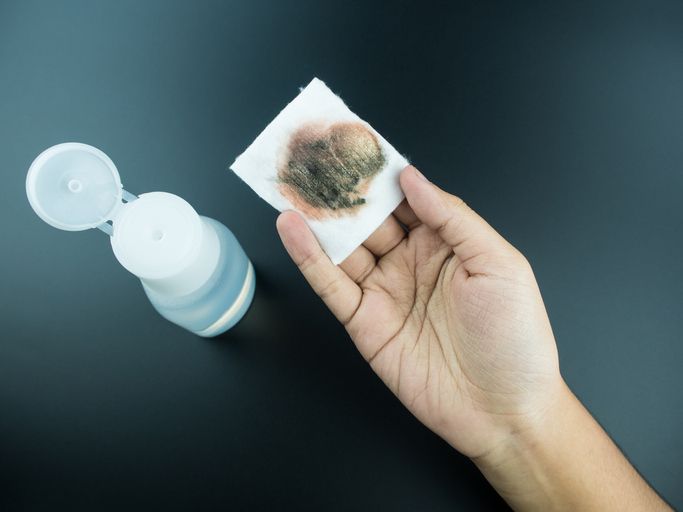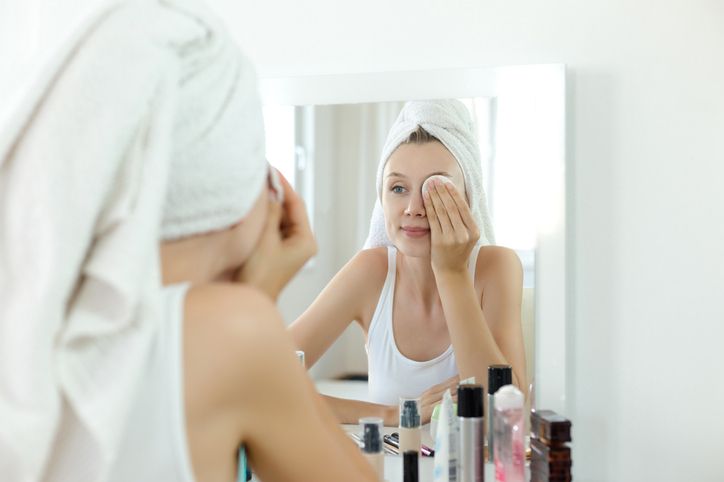- Home
- Trend
- Weight Loss Strategies
- Acne Tips
- Hair Health Information
- Blemish Removal Tips
- Acne Scar Removal Tips
- Muscle Building Techniques
- Intimate Care Tips
- Postpartum Intimate Care
- Eye Bags Wiki
- Tips for Face Slimming
- Secret of Permanent Hair Removal
- Breast Enlargement Tips
- Cure to Snoring
- Marionette Lines
- Skin-Tightening Secrets
Makeup removal has become second nature for many in modern society—especially those who wear makeup regularly. But are you really removing your makeup correctly? In an era where appearances are everything, daily makeup isn’t just about looking your best—it’s also a sign of respect and social etiquette. However, if makeup isn't properly removed, the leftover dirt and residue can trigger a variety of skin issues. Let’s explore the six most common types of makeup removers and bust some widespread myths so you can thoroughly cleanse your skin and avoid unwanted consequences!
What Is Makeup Removal?

As the name suggests, makeup removal refers to eliminating all cosmetic products from the face. This step is crucial in the nighttime skincare routine. Before using a cleanser, makeup and impurities should be thoroughly removed from the skin. Only when your skin feels fresh and light can you say you've really shed the burden of both makeup and daily stress. Makeup removal is also an important ritual for relaxing both mind and body after a long, tiring day.
Cleansers alone can't fully remove makeup residue, which is why skincare experts developed makeup removers specifically for this purpose. These products are formulated to remove long-wearing, stubborn cosmetic chemicals that remain on the skin throughout the day.
Still think removing makeup is unnecessary? “I don’t see any makeup left after washing with a cleanser,” you might say. Think of your daily makeup as a mask. If the mask isn’t removed, how can you fully reach your skin? Makeup acts like a barrier between your skin and the environment. While regular cleansers may seem to have removed all visible makeup, what the naked eye can't detect are the chemical residues still lodged in your pores—often mixed with outdoor pollutants. These must be properly removed before continuing with your skincare routine so your skin's natural turnover process isn't disrupted.
Why Is Makeup Removal So Important?

As mentioned, removing makeup helps prevent harmful substances from remaining in your pores and damaging your skin. Many people underestimate the impact of cosmetic products, but because they contain minerals and a mix of additives, they can accelerate skin aging through constant close contact with the skin. This is easy to notice—anyone who wears makeup can feel the difference as the day goes on.
You might feel flawless right after applying makeup, but within hours, your skin starts producing oil, and your base makeup begins to feel dry and uncomfortable. These are signs of cosmetic oxidation. If not thoroughly removed, oxidized residue can clog pores and lead to inflammation, resulting in sensitive, acne-prone skin. The loss of moisture and collagen also becomes more severe, prematurely aging your skin.
免費體驗
Acne Treatment
1 Minute Self-Registration
Date should not be before minimal date
How Do You Know If You’ve Removed All Your Makeup?
Given how important makeup removal is, how can we know whether our pores are truly clean when we can’t see inside them?
After removing your makeup, observe your skin’s surface. If it doesn’t feel patchy, dampen a cotton pad with makeup remover and gently wipe in one direction. If there’s no visible residue or discoloration on the pad, your skin is clean.
For eye and lip areas, which often involve waterproof products, use a cotton swab to gently wipe the corners of the eyes, eyelids, and lips. This is a gentle and effective way to ensure even the most stubborn makeup is gone.
The 6 Most Common Types of Makeup Removers
1. Micellar Water / Cleansing Water
Micellar water is the most common and widely available type of remover. It has a light, watery texture and offers a refreshing cleansing experience—ideal for removing light makeup and daily grime. While it doesn’t require emulsification and is easy to use, its cleansing power is generally weaker, requiring several applications to completely clean the face.
2. Cleansing Oil
Cleansing oils are popular among many makeup users. Though they have an oily consistency, they’re not overly thick and offer the strongest cleansing power among all types—perfect for removing heavy or waterproof makeup. However, they do require emulsification. Some variants also include nourishing plant-based oils that help retain moisture while cleansing the skin.
3. Cleansing Milk
With a texture between water and oil, cleansing milk combines makeup removal with moisturizing benefits. It's especially suitable for mature or dry skin types and for those who dislike oily residue. Like cleansing oil, it also needs to be emulsified before rinsing thoroughly.
4. Cleansing Balm / Cream
These solid-form removers (often packaged in small jars) have a soft, ice-cream-like texture and are travel-friendly. Balms are gentle on the skin and less greasy than cleansing oils. However, they take longer to emulsify and usually require warm palms and lukewarm water for full effectiveness.
5. Cleansing Gel
These feel like hydrating gel products—clear and jelly-like. Ideal for oily skin types and light makeup, especially in hot or humid weather. While not as powerful as cleansing oils, gels cleanse effectively without disrupting the skin’s natural oil balance.
6. Cleansing Lotion (Lotion-Type Makeup Remover)
Also known as cleansing toner or water, this is typically used after other removers to eliminate leftover residue. Though weaker in cleansing strength, it often includes high levels of moisturizing ingredients, on par with toners. It’s best used after primary makeup removal to ensure a final, hydrating clean.
How to Choose the Right Makeup Remover: 5 Key Tips
1. Cleansing Power
The core function of a remover is its ability to thoroughly cleanse. Each type has pros and cons—some are more powerful but less pleasant to use. If you wear waterproof or heavy makeup regularly, go for high-strength removers, especially dedicated eye and lip removers.
2. Match It to Your Skin Type
Different skin types require different products.
• Oily skin: Avoid cleansing oils, milk, or balms as they may worsen oiliness. Use micellar water or cleansing gels.
• Dry, normal, or combination skin: Cleansing balms or milk are ideal, especially for their moisturizing properties.
• Sensitive skin: Always check the ingredients to avoid irritants.
3. Check the Ingredients
Look for nourishing and non-irritating components like Vitamin E (an antioxidant that aids in emulsifying makeup), natural plant extracts, gentle oils, and moisturizing agents. Avoid overly chemical-heavy formulas.
4. Stay Within Budget
Don’t be swayed by high prices—expensive doesn’t always mean better. Look for affordable options with safe ingredients and adequate cleansing power.
5. Read Reviews
Be cautious about influencer endorsements. Before buying, check real user reviews on official or e-commerce platforms. If good reviews vastly outnumber the bad, it’s likely worth a try.
免費體驗
Acne Treatment
1 Minute Self-Registration
Date should not be before minimal date
4 Common Myths About Makeup Removal—Do You Still Need to Remove Makeup If You Didn’t Wear Any?
1. Do I need to remove makeup if I didn’t wear any?
Yes! Even if you didn't apply foundation, powder, eyeliner, or lipstick, if you used sunscreen or a tinted base product, you still need to remove it. Those with oily skin can benefit from wiping excess sebum with micellar water before cleansing.
2. Is partial makeup removal necessary?
Not for light makeup—a single remover will do. But for heavy makeup, use dedicated eye and lip removers to avoid dryness or irritation in delicate areas.
3. How many times do I need to cleanse for it to be truly clean?
After you think your makeup is fully removed, test with a cotton pad or swab soaked in micellar water. If there's no residue, you're good to go.
4. Why do I still need to wash my face after removing makeup?
It depends on your environment. In humid climates, washing your face after removing makeup is essential. In dry climates, over-cleansing can dry out the skin, so proceed with caution.
Learn to Remove Makeup the Right Way—Step-by-Step to Flawless Skin
For Liquid Removers
Apply to a cotton pad, saturate thoroughly, and gently wipe your face in one direction—never rub back and forth. Repeat until no more residue is seen on the cotton pad.
For Oils, Milks, and Balms
Warm the product between your palms, then gently massage it onto your face. As makeup dissolves, emulsify with a bit of lukewarm water. Once the remover turns milky white, rinse thoroughly.
Post-Removal Skincare
After removing makeup, your skin is vulnerable. Follow up with toner, serum, and moisturizer suited to your skin type. In the daytime, always use sunscreen to minimize sensitivity and prevent damage.
Breakouts from Improper Makeup Removal? Perfect Medical Acne Treatment Helps You Banish Pimples for Good!
Skin issues caused by improper makeup removal left me anxious about my appearance—I desperately wanted fast, visible results to clear acne and improve skin texture... Don’t panic! We highly recommend the Perfect Medical Acne Treatment, a risk-free and exceptionally safe option! It not only targets stubborn acne but also leaves no room for blackheads, whiteheads, clogged pores, or acne scars. Suitable for all skin types!
As the name suggests, the Perfect Medical Acne Treatment is designed to transform acne-prone skin. It uses a dual-spiral suction and drainage technology to extract impurities, sebum, toxins, and dead skin cells from deep within the pores—up to 30–35mm below the skin surface. After deep cleansing, the skin needs immediate replenishment, so the therapist will apply medically developed serums to stimulate rapid collagen production. These nourishing ingredients are infused into the dermis, restoring plump, firm, and flawless skin within just a few sessions!
The non-invasive nature of the Perfect Medical Acne Treatment ensures there are no wounds or scarring, and the entire process is comfortable and pain-free. Our professional team will also follow up with your progress, so you never need to worry about acne returning or being left without a solution. Sign up now to enjoy a free professional skin analysis + Perfect Medical Acne Treatment, and if you like our Facebook page, you’ll also receive a whitening and hydrating face mask! Limited slots available—act fast!
Experience it Now: Perfect Medical Acne Treatment免費體驗
Acne Treatment
1 Minute Self-Registration
Date should not be before minimal date
FAQ

Why is removing makeup essential?
To prevent oxidized particles in cosmetics from damaging the skin.
What happens if I don’t remove my makeup?
It can lead to issues like enlarged pores, increased acne and blackheads, and in severe cases, dermatitis.
How long can I go without removing makeup?
It’s recommended to remove your makeup after 8 hours of wear.
Is it okay to exercise while wearing makeup?
As long as it doesn’t interfere with sweating, it’s fine.
Does cleansing oil cause breakouts?
No—if you rinse it off thoroughly, it won’t cause acne.









